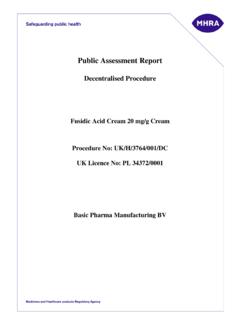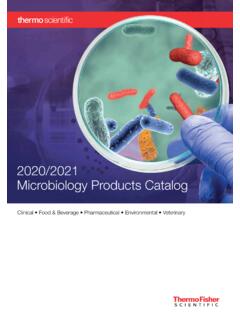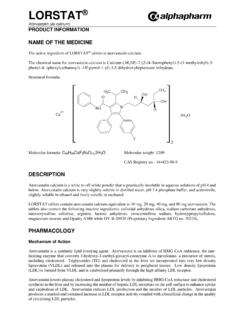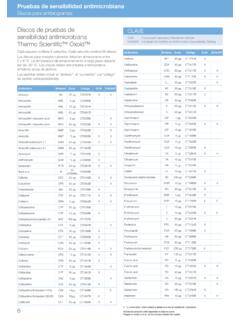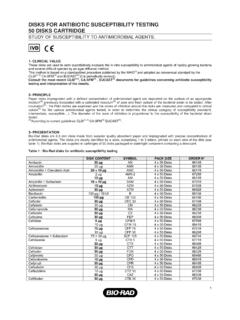Transcription of Fucithalmic PM 1.01 20-AUG-2008 - LEO Pharma
1 PRODUCT MONOGRAPH PrFUCITHALMIC fusidic acid 1% Viscous Eye Drops Topical Ophthalmic Antibiotic LEO Pharma Inc. Thornhill, Ontario L3T 7W8 Date of Revision: August 20, 2008 Variation No.: 01 Registered trademark of LEO Pharma A/S used under license by LEO Pharma Inc., Thornhill, ON PrFUCITHALMIC LEO Fucithalmic ( fusidic acid ) Product Monograph, version ( ) Page 2 of 28 fusidic acid 1% Viscous Eye Drops THERAPEUTIC CLASSIFICATION Topical Ophthalmic Antibiotic ACTION AND CLINICAL PHARMACOLOGY Fucithalmic Viscous Eye Drops contain the antibiotic fusidic acid . The antibacterial action of fusidic acid results from the inhibition of bacterial protein synthesis. fusidic acid interferes with amino acid transfer from aminoacyl-tRNA to protein on the ribosomes.
2 fusidic acid may be bacteriostatic or bactericidal depending on inoculum size. Although bacterial cells stop dividing almost within two minutes after contact with the antibiotic in vitro, DNA and RNA synthesis continue for 45 minutes and 1-2 hours, respectively. fusidic acid has a steroid like structure but does not exhibit any steroid like pharmacological activity (ie. hormonal or anti-inflammatory effects). Fucithalmic is a 1% microcrystalline suspension of fusidic acid in a carbomer gel. The sustained release formulation of Fucithalmic provides prolonged contact with the eye. Pharmacokinetic studies in humans demonstrated that 1 hour following administration of a single drop of Fucithalmic into the fornix of the eye, fusidic acid concentrations in lacrimal fluid ranged between to 40 mcg/mL.
3 fusidic acid concentrations ranged between to mcg/mL 12 hours after administration. Median antibiotic levels of mcg/mL are maintained for 12 hours in aqueous humour. Since high ocular concentrations of fusidic acid are achieved after topical application of Fucithalmic , standardized susceptibility tests may not be appropriate to predict clinical effectiveness LEO Fucithalmic ( fusidic acid ) Product Monograph, version ( ) Page 3 of 28 INDICATIONS AND CLINICAL USE Fucithalmic Viscous Eye Drops ( fusidic acid ) are indicated for the treatment of superficial infections of the eye and its adnexa (ie., conjunctivitis) caused by fusidic acid susceptible strains of the designated bacteria in adults and children ( 2 years of age): Staphylococcus aureus, Streptococcus pneumoniae and Haemophilus influenzae.
4 Enterobacteriaciae and Pseudomonas are resistant to fusidic acid . There are currently no NCCLS approved standards for testing in vitro susceptibility of conjunctival isolates toward topical ophthalmic antibiotics, including fusidic acid . CONTRAINDICATIONS Fucithalmic Viscous Eye Drops ( fusidic acid ) (multi-dose preserved preparation and unit dose unpreserved preparation) are contraindicated in patients with hypersensitivity to fusidic acid or any of the other components of the preparations. Refer to PHARMACEUTICAL INFORMATION (Composition section). The component benzalkonium chloride in the preserved preparation can be allergenic. A preservative free unit dose formulation of Fucithalmic is available for patients with known or suspected hypersensitivity to benzalkonium chloride.
5 WARNINGS Fucithalmic Viscous Eye Drops ( fusidic acid ) are not for injection into the eye. LEO Fucithalmic ( fusidic acid ) Product Monograph, version ( ) Page 4 of 28 PRECAUTIONS Prolonged use of Fucithalmic Viscous Drops ( fusidic acid ) may result in overgrowth of nonsusceptible organisms, including fungi. If superinfection or drug resistance occurs, treatment should be discontinued and appropriate therapy should be initiated. Whenever clinical judgement dictates, the patient should be examined with the aid of magnification, such as slit lamp biomicroscopy and, where appropriate, fluorescein staining. If irritation (other than transient stinging upon administration) or sensitization to any of the components of Fucithalmic develops, then treatment should be discontinued.
6 Contact lenses (hard or soft) should not be worn during treatment with Fucithalmic . Wearing contact lenses concomitant with an infection could cause eye damage. Treatment with Fucithalmic while wearing contact lenses has not been studied in clinical trials. In addition, the preservative benzalkonium chloride in Fucithalmic multidose vials may deposit in contact lenses. Patient should be advised to avoid contaminating the tip of the Fucithalmic multi-dose tube through contact with the eye, eyelid or any other objects during administration. Pregnancy There are no adequate and well controlled studies in pregnant women. Therefore, the use of Fucithalmic in pregnancy requires that the benefits be weighed against the potential risks to the foetus.
7 fusidic acid has been shown to penetrate the placental barrier of humans following systemic administration. Animal studies have not demonstrated teratogenicity with fusidic acid . Lactation Following systemic administration of fusidic acid , the drug has been detected in the milk of nursing mothers. The use of Fucithalmic while nursing requires that the benefits be weighed against the potential risks to the nursing infant. LEO Fucithalmic ( fusidic acid ) Product Monograph, version ( ) Page 5 of 28 Paediatric Use Quantitative bacteriology studies have not been conducted in children <2 years of age and thus the efficacy of Fucithalmic has not been established. The incidence and spectrum of adverse reactions in children <2 years is similar to children 2 years of age.
8 Use in Neonates Fucithalmic should not be used in the treatment of neonatal conjunctivitis. The etiology of bacterial conjunctivitis in neonates can be different as compared to adults and children. Fucithalmic has inadequate antibiotic activity toward pathogens associated with neonatal conjunctivitis (eg., Chlamydia, Pseudomonas, Neisseria gonorrhea, Coliforms etc.). Treatment of neonates should not be empirical but instead based on a diagnosis of conjunctivitis established following culture of conjunctival samples. Drug Interactions There is no clinical trial experience of concomitant use of Fucithalmic with other ophthalmic preparations ADVERSE REACTIONS Adverse drug reactions (events deemed possibly or probably related to Fucithalmic Viscous Drops ( fusidic acid )) were reported for of clinical trial patients (n=1214 patients studied) with requiring discontinuation of treatment.
9 The most frequent reaction was transient stinging or irritation upon administration ( of patients). Severity was usually mild and discontinuation of therapy was not required. In clinical trials, adverse drug reactions reported for <1% of patients include transient burning sensation and/or tearing, eye soreness, eyelid edema, eyelid stickiness, temporary blurring of vision immediately after administration, headache, and worsening of conjunctivitis. Reactions reported by of patients include: localized allergic reaction, cobblestone appearance of the conjunctival sulcros, eyelid abscess, eye pain, tired eyes, skin rash, urticaria, oral candidiasis, chest infection, tonsillitis, enuresis, loss of appetite, and vomiting. LEO Fucithalmic ( fusidic acid ) Product Monograph, version ( ) Page 6 of 28 Hypersensitivity reactions to Fucithalmic are reported rarely and have been characterized by urticaria (localized or generalized).
10 Cross-hypersensitivity between fusidic acid and other antibiotics has not been reported. SYMPTOMS AND TREATMENT OF OVERDOSAGE There is no experience with overdosage of Fucithalmic Viscous Drops ( fusidic acid ). DOSAGE AND ADMINISTRATION Adults and children ( 2 years): Instill 1 drop of Fucithalmic Viscous Drops ( fusidic acid ) into the conjunctival sac of both eyes every 12 hours (ie., twice daily application) for 7 days. If clinical resolution has not been achieved after 7 days of treatment, the patient should be re-evaluated. LEO Fucithalmic ( fusidic acid ) Product Monograph, version ( ) Page 7 of 28 PHARMACEUTICAL INFORMATION Drug Substance Proper Name: fusidic acid Hemihydrate Chemical Name: ent-(17 )-16 -(Acetyloxy)-3 ,11 -dihydroxy-4 ,8,14-trimethyl-18-nor-5 ,10 -cholesta-17(20),24-dien-21-oic acid hemihydrate Structural Formula: Molecular Formula: C31H48O6, H2O Molecular Weight: Description: A white or almost white crystalline powder.
![[Product Monograph Template - Standard]](/cache/preview/b/5/6/4/6/9/f/8/thumb-b56469f81fe4cee7737b379eed8967bf.jpg)


